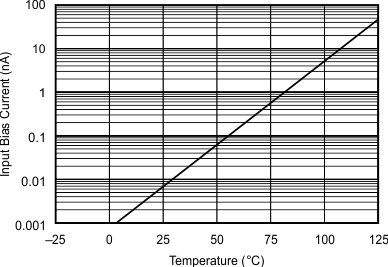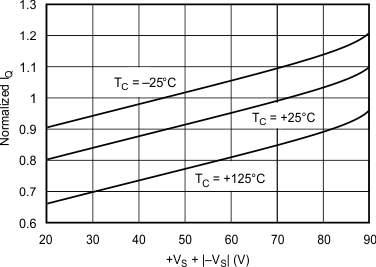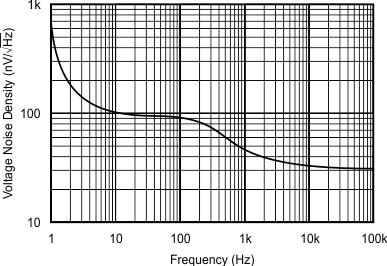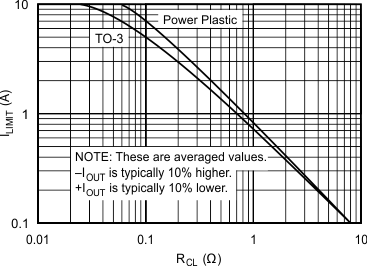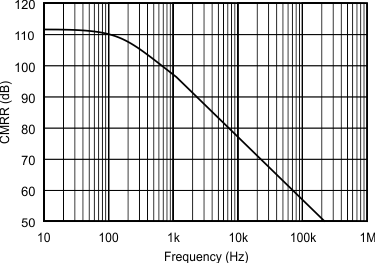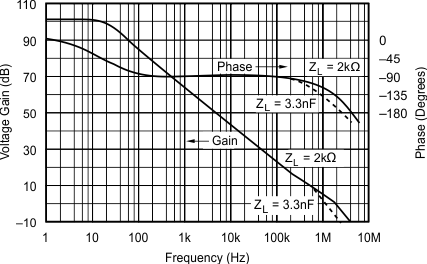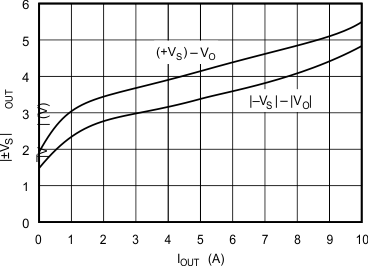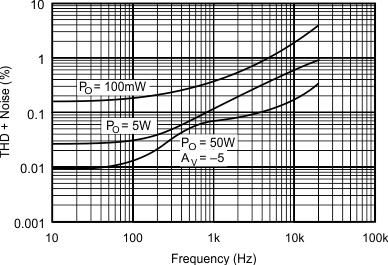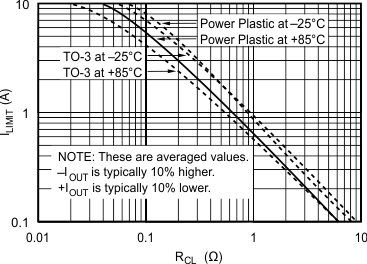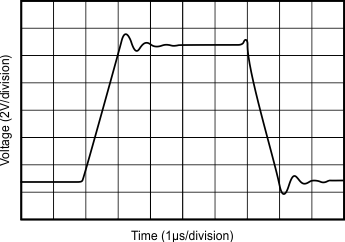SBOS153B September 2000 – January 2016 OPA541
PRODUCTION DATA.
- 1 Features
- 2 Applications
- 3 Description
- 4 Revision History
- 5 Pin Configuration and Functions
- 6 Specifications
- 7 Detailed Description
- 8 Application and Implementation
- 9 Power Supply Recommendations
- 10Layout
- 11Device and Documentation Support
- 12Mechanical, Packaging, and Orderable Information
Package Options
Mechanical Data (Package|Pins)
Thermal pad, mechanical data (Package|Pins)
Orderable Information
6 Specifications
6.1 Absolute Maximum Ratings
over operating free-air temperature range (unless otherwise noted) (1)| MIN | MAX | UNIT | ||
|---|---|---|---|---|
| Supply voltage, +VS to –VS | 80 | V | ||
| Output current | See SOA, Figure 11 | |||
| Power dissipation, Internal(2) | 125 | W | ||
| Input voltage, differential | +VS | |||
| Input voltage, common-mode | +VS | |||
| Temperature, pin solder, 10 s | 300 | °C | ||
| Junction temperature(2) | 150 | °C | ||
| Operating temperature (case) | AP | –40 | 85 | °C |
| AM, BM, SM | –55 | 125 | ||
| AP | –25 | 85 | ||
| Storage temperature, Tstg | AM, BM, SM | –65 | 150 | °C |
(1) Stresses beyond those listed under Absolute Maximum Ratings may cause permanent damage to the device. These are stress ratings only, which do not imply functional operation of the device at these or any other conditions beyond those indicated under Recommended Operating Conditions. Exposure to absolute-maximum-rated conditions for extended periods may affect device reliability.
(2) Long term operation at the maximum junction temperature will result in reduced product life. Derate internal power dissipation to achieve high MTTF.
6.2 ESD Ratings
| VALUE | UNIT | |||
|---|---|---|---|---|
| V(ESD) | Electrostatic discharge | Human-body model (HBM), per ANSI/ESDA/JEDEC JS-001(1) | ±2000 | V |
| Charged-device model (CDM), per JEDEC specification JESD22-C101(2) | ±250 | |||
(1) JEDEC document JEP155 states that 500-V HBM allows safe manufacturing with a standard ESD control process.
(2) JEDEC document JEP157 states that 250-V CDM allows safe manufacturing with a standard ESD control process.
6.3 Recommended Operating Conditions
over operating free-air temperature range (unless otherwise noted)| MIN | MAX | UNIT | ||
|---|---|---|---|---|
| Supply Voltage (V+ – V–) | 10 (±5) | 80 (±40) | V | |
| Specified temperature | –40 | 125 | °C | |
6.4 Thermal Information
| THERMAL METRIC(1) | OPA541 | UNIT | ||
|---|---|---|---|---|
| KV (TO-220) | LMF (TO-3) | |||
| 11 PINS | 8 PINS | |||
| RθJA | Junction-to-ambient thermal resistance | 21.5 | — | °C/W |
| RθJC(top) | Junction-to-case (top) thermal resistance | 17.4 | — | °C/W |
| RθJB | Junction-to-board thermal resistance | 9.2 | — | °C/W |
| ψJT | Junction-to-top characterization parameter | 1.5 | — | °C/W |
| ψJB | Junction-to-board characterization parameter | 9.2 | — | °C/W |
| RθJC(bot) | Junction-to-case (bottom) thermal resistance | 0.1 | 3 | °C/W |
(1) For more information about traditional and new thermal metrics, see the Semiconductor and IC Package Thermal Metrics application report, SPRA953.
6.5 Electrical Characteristics
At TC= 25°C and VS = ±35 VDC, unless otherwise noted.| PARAMETER | TEST CONDITIONS | MIN | TYP | MAX | UNIT | ||
|---|---|---|---|---|---|---|---|
| INPUT OFFSET VOLTAGE | |||||||
| VOS | Input offset voltage | Specified temperature range VS = ±10 V to ±VMAX |
OPA541AM/AP | ±2 | ±10 | mV | |
| OPA541BM/SM | ±0.1 | ±1 | |||||
| vs temperature | OPA541AM/AP | ±20 | ±40 | µV/°C | |||
| OPA541BM/SM | ±15 | ±30 | |||||
| vs supply voltage | OPA541AM/AP, OPA541BM/SM |
±2.5 | ±10 | µV/V | |||
| vs power | ±20 | ±60 | µV/W | ||||
| IB | Input bias current | 4 | 50 | pA | |||
| IOS | Input offset current | ±1 | ±30 | pA | |||
| Specified temperature range | 5 | nA | |||||
| INPUT CHARACTERISTICS | |||||||
| Common-mode voltage range | Specified temperature range | ±(|VS| – 6) | ±(|VS| – 3) | V | |||
| Common-mode rejection | VCM = (|±VS| – 6 V) | 95 | 113 | dB | |||
| Input capacitance | 5 | pF | |||||
| Input impedance, DC | 1 | TΩ | |||||
| GAIN CHARACTERISTICS | |||||||
| Open-loop gain at 10 Hz | RL = 6 Ω | 90 | 97 | dB | |||
| Gain-bandwidth product | 1.6 | MHz | |||||
| OUTPUT | |||||||
| Voltage swing | IO = 5 A, continuous | ±(|VS| – 5.5) | ±(|VS| – 4.5) | V | |||
| IO = 2 A | ±(|VS| – 4.5) | ±(|VS| – 3.6) | |||||
| IO = 0.5 A | ±(|VS| – 4) | ±(|VS| – 3.2) | |||||
| Peak current | 9 | 10 | A | ||||
| AC PERFORMANCE | |||||||
| Slew rate | 6 | 10 | V/µs | ||||
| Power bandwidth | RL = 8 Ω, VO = 20 Vrms | 45 | 55 | kHz | |||
| Settling time to 0.1% | 2-V Step | 2 | µs | ||||
| Capacitive load | Specified temperature range, G = 1 | 3.3 | nF | ||||
| Specified temperature range, G > 10 | SOA(1) | ||||||
| Phase margin | Specified temperature range, RL = 8 Ω | 40 | °C | ||||
| ±VS | Power supply voltage | Specified temperature range | ±10 | ±30 | ±35 | V | |
| Quiescent current | 20 | 25 | mA | ||||
| TCASE | Temperature range | AM, BM, AP | –25 | 85 | °C | ||
| OPA541BM/SM | –55 | 125 | |||||
(1) SOA is the Safe Operating Area shown in Figure 11.
6.6 Typical Characteristics
At TA = 25°C, VS = ±35 VDC, unless otherwise noted.